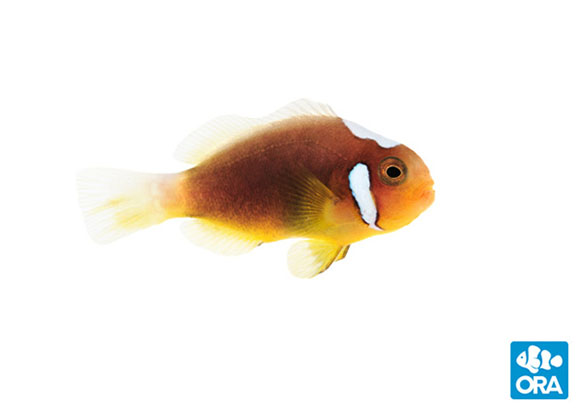ORA finally debuted a project that they’ve been working on for a year (well, actually a decade if you count the total time they’ve pursued this clownfish variety). We finally have commercially available captive-bred F1 Amphiprion leucokranos, the White Bonnet Clownfish, and from reading the info it would seem that these are purely Solomon Islands provenance fish as well. ORA initially suggested that these fish would be released in early winter 2014, but as ORA now states, this is one of the slowest growing clownfish they’ve produced (so much for hybrid vigor?). You may have seen these fish teased at MACNA 2014, and now they’re finally available for purchase through ORA retailers.
One of the most interesting findings is that the Leucokranos, while showing considerable variation in the offspring patterns, do not show “throwbacks” to either of the suspected parental species, A. chrysopterus or A. sandaracinos. I know this is surprising some; people seem to have the notion that hybrid offspring should range between the parental forms on a continuum between the parental species, particularly in a 2nd generation mating. That said, the reality is that in the first generation of a hybrid, only 50% of the genes are contributed by each parent, which means the resultant hybrid offspring in such a primary hybrid are relatively uniform (this is why, for example, MOCHA Clownfish are consistent in their appearance in my opinion).
And by the same token, if you take any 2 of those offspring and mate them together, they are each 50/50 concoctions of the parental species, and yet only contribute 50% of their genetic material again. While it is hypothetically possible that both fish could, in theory, randomly contribute all the genes inherited from only one of the parental species, thus perhaps resulting in a fish that resembled a throwback, the practical result is that the F2 generation is simply another round of genetic coin tossing and reshuffling. As such, you seem to get more of the same, and not the “continuum” that some expect. Simply put, in my opinion, the odds are so astronomically small, which means while the makeup may drift to 45% one species, 55% the other in some offspring, more or less a 50/50 split is going to remain in subsequent generation unless selective pressures or outright back crosses to a parental species are applied.

ORA also instituted a very novel grading concept with the introduction of their White Bonnets. This move garnered a little bit of negative sentiment in online circles, which I might sum up best as “really, we need to have premium and ultra vs. standard White Bonnets”? I understand the sentiments, but in a “species” with such variation in the offspring, the fact is that people will have preferences for one form vs. another. ORA certainly believes that a headstripe which connects to the back-stripe is the most idealized form, so that is the grade at the “top” of the spectrum.
Me? I like the ones with a cap and a cheek mark, separated. And that’s really the point – the grading system isn’t about marketing HYPE, it’s about marketing and managing the expectations of ORA’s customers. ORA’s approach is very objective vs. subjective…no hype involved (in my opinion) and it’s really no different than sorting out the “misbarred” Ocellaris and selling them separately from the ones with “good” bars.
Visit ORA’s Blog for more information on this introduction.



